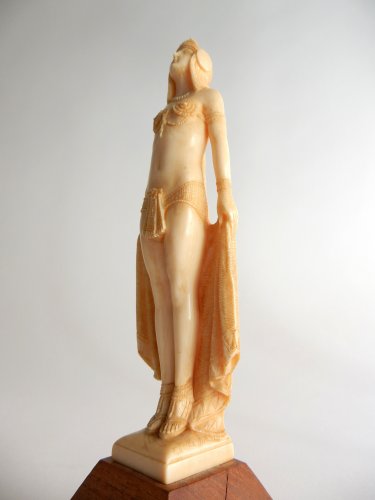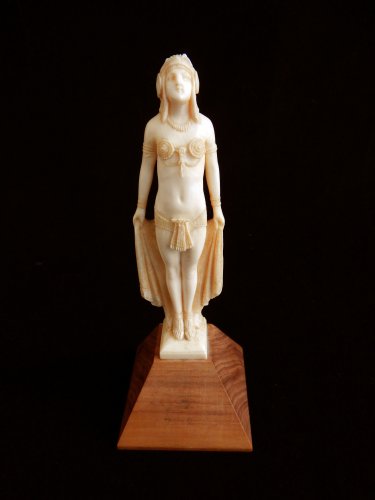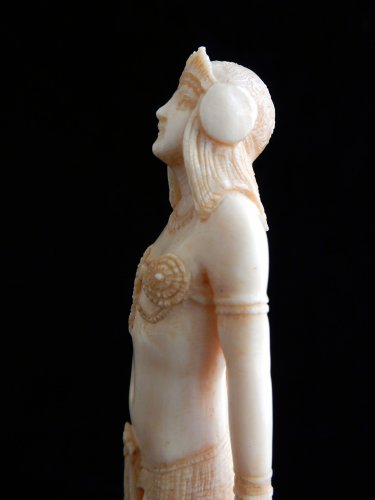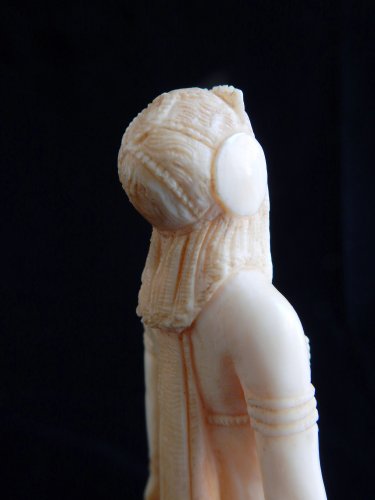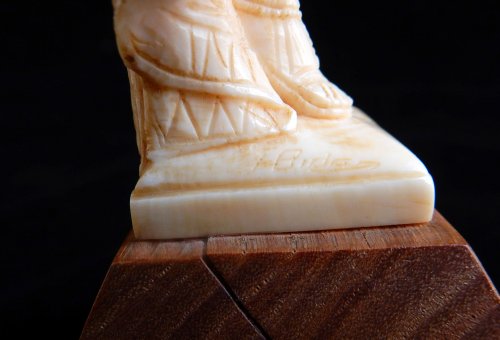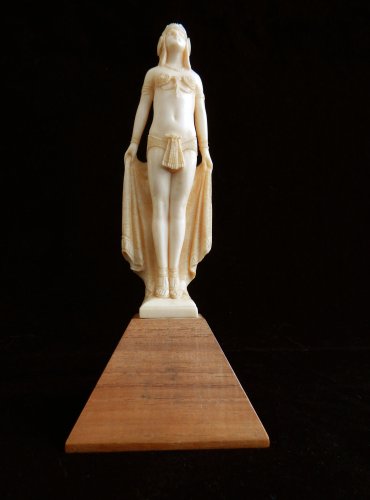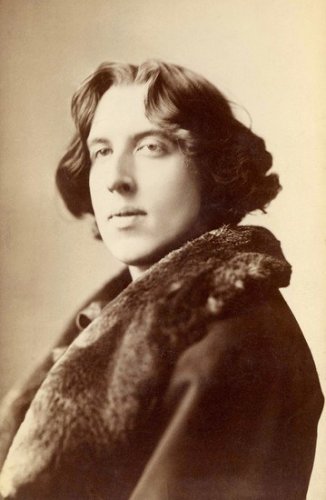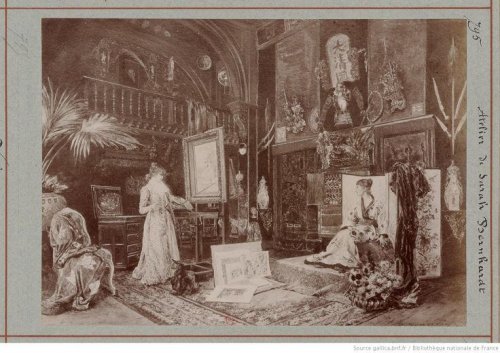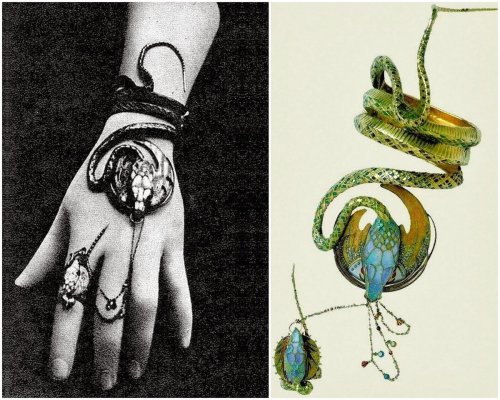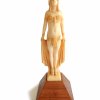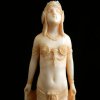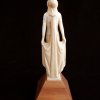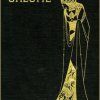Eugène Bidau (1839-1899) Ivory sculpture of Sarah Bernhardt as Salomé
About this piece
Very refined and directly cut ivory sculpture of the legendary actrice Sarah Bernhardt (Fr. 1844-1923) as Salomé, she played the part of Salomé in 1896 in the controversial play written by Oscar Wilde (Ireland,1854-1900).
It's made by the artist and painter Eugène Bidau (Fr,1839-1923), a good friend of Sarah Bernhardt. He was a successful painter, known for his remarkable still lifes of flowers, sometimes accomplished by exotic birds. He participate at the Paris Salons for 30 years. Sarah Bernhardt was besides a good friend also a mecenas for him. The well known painting of Bidau "Touffe de violettes de Parme" was part of Sarah Bernhardt's private collection.
The ivory sculpture which he made especially for Sarah Bernhardt, belonged to her private collection.
The statue is signed with 'Bidau' in the ivory and underneath the wooden base is a seal from Marcilhac and some written notes about the statue. Félix Marcilhac, a very well known art historian, writer, collector, founder of the famous Gallery Marcilhac in Paris did some research to this statue and he discovered the statue belonged to the private collection of Sarah Bernhardt and was auctioned at the auction of 1923 where, after the death of Sarah Bernhardt, her collection was auctioned.
The story behind this unique and beautiful cut piece is very intriguing, it connect different famous persons and their passion for art together and it will give a nice view in a time which is so defying of the Art history, some people call it the birth of Modern Art. Because of the new machines and the very high level of craftsmanship the art developed different and new ways to discover new possibilities. But also the moral changes, the modern times and the new discoveries made people more aware of themselves and their role in the society.
Sarah Bernhardt (Paris, 1844-1923), pseudonym of Rosie Bernardt, was born as the daughter from the Dutch courtesan Julie Bernardt, her father was unknown.
During her lifetime she became a very famous actrice, not only in France but also in New York, London, Amsterdam and Anvers. She is one of the actrices everybody know, even today, because she is painted, sculptured, her face is visible on old affiches, many photographs and even on film, as one of the first at that time.
She loves the Art, and especially the Art Nouveau, very modern by then. She was sculptor herself and a mecenas for several artists. For instance René lalique designed many jewelry for her, Alphonse Mucha, designed her famous bracelet shaped as a snake, but he also portrayed her on many of his paintings and affiches. World famous by now. Alfred Dagouet, made several pieces on commisssion for her, his very special embossed boxes are a rare find these days.
Sarah Bernhardt never married, she had several lovers and from one of them , the Belgian nobleman, Charles-Joseph Lamoral De Ligne, son of the 8th Prince De Ligne, she got a son, Maurice Bernhardt (1864-1928). But she also had a relation with the 37 years younger, Dutch actor Lou Tellegen. We would call her a cougar by now. She must be very brave, because she was 52 years old when she played the role of Salomé, she had to dance in costumes which are very erotic.
She was a very modern, talented, independent and also a dedicated woman, for instance the letter she published in the news paper as a support for Emile Zola in the Dreyffus affaire, but also her front role in the development of photography and film, all very new and unknown at her time.
In 1891 Sarah had a performance in London, where she met the famous and controversial writer Oscar Wilde, he was already writing on his play "Salomé". He adored Sarah Bernhardt, from him she got her nickname "The divine Sarah". He asked her to play the role of Salomé in his new play. The première would be hold in London.
Salomé is based on the story mentioned in the Bible, where Herodes Antibus his stepdaughter asked to dance for him on a party. When she does, she can ask anything she wants. Influenced by her mother Salomé asked the head of John the Baptist. She danced the dance of the 7 voiles, a very erotic dance.
In the piece of Wilde, Salomé kissed the chopped head. Therefore the part is seen as influenced by the Art movement of the Symbolism.
In England, where Oscar Wilde was very notorious because of his flamboyant lifestyle and his relationship with men, they forbid the première of the play. It was censured by Lord Chaimberlain. Not because of the dances or the costumes, or even the kiss on the chopped head, but because the existment of a long forgotten law which said it's forbidden to play a biblical figure on a stage. Salomé had his world première eventually in Paris, in 1896. It became a big success and it inspired many artist to use the theme in their work, for instance Richard Strauss wrote the opera "Salomé" (1905) where he used the play from Wilde as a libretto. Bitter detail is, while the play of Salomé had his premiere, Oscar Wilde couldn't be present and enjoyed his success. He stayed at an English prison because gross indecent acts. The original accuse was sodomy. He was imprisoned and forced labour during 2 years. In prison he became ill, tuberculoses, and he died as a very poor man in France, where he went after his imprisonment. Remarkably, it took till 1931, the play Salome from Oscar Wilde was performed in a public theatre, "The Savoy Theatre'.
Condition
Goed
Material:
Ivory
Measurements:
Height: 17 cm
(6,69")
Year:
Origin:
France
Artist / atelier:
Eugène Bidau


